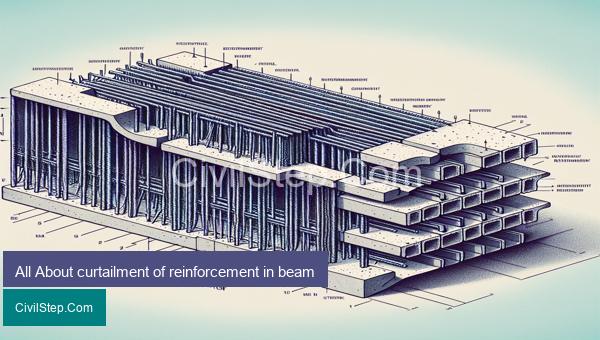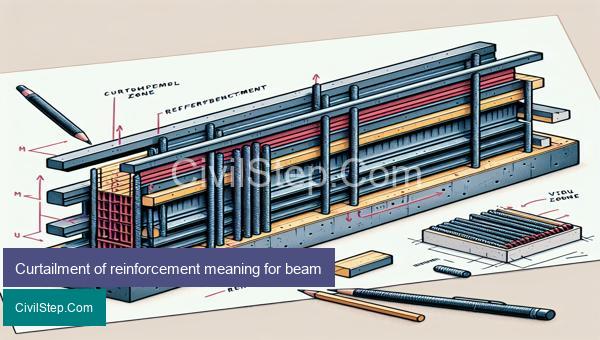
Curtailment of reinforcement in beams is an important concept in structural engineering that involves the reduction of reinforcing bars at the end of a beam. This technique is commonly used to reduce the cost and construction time of a project, while still maintaining the required strength and stability of the structural element. In this article, we will delve into all aspects of curtailment of reinforcement in beam, including its purpose, design considerations, and guidelines for its implementation. By understanding the principles behind this technique, engineers can make informed decisions when designing and constructing beams, ensuring safe and efficient structures.
What is curtailment of reinforcement in beam

Curtailment of reinforcement in beam is a process used in construction to reduce the amount of reinforcement required in a concrete beam. It involves calculating the required amount of reinforcement based on the structural requirements and then placing the reinforcement bars only in areas where they are most needed, rather than throughout the entire stretch of the beam.
The main purpose of curtailment of reinforcement is to optimize the use of materials and reduce the cost of construction without compromising the structural integrity and strength of the beam. This technique is commonly used in concrete beams that are not exposed to heavy loads or bending moments.
The process of curtailment of reinforcement starts with determining the required amount of reinforcement based on the design and structural analysis. This is done by considering the type of load the beam will be subjected to, the span of the beam, and the type of reinforcement used.
Once the required reinforcement is calculated, engineers then decide on where to place the reinforcement. In general, the reinforcement is placed at locations where the bending moments and shear forces are the highest. These are typically found at the ends and at mid-spans of the beam.
In some cases, it may be necessary to use additional reinforcement at specific locations to control cracking or to provide extra strength to the beam. However, this must be carefully evaluated to ensure that the additional reinforcement does not offset the cost savings achieved through curtailment.
Curtailment of reinforcement not only reduces the cost of construction but also leads to shorter construction time as fewer reinforcement bars need to be placed and tied. It also reduces the congestion of reinforcement, making it easier to pour and compact concrete, resulting in a better quality beam.
It is worth noting that curtailment of reinforcement should only be used in beams that are not subjected to heavy loads. If the beam is expected to carry heavy loads or is designed for specialized purposes, such as earthquake resistance, then traditional reinforcement techniques should be used to ensure the structural stability and safety of the structure.
In conclusion, curtailment of reinforcement is a valuable technique used in beam construction to optimize the use of materials and reduce construction costs. It requires careful calculation and evaluation by qualified engineers to ensure the structural integrity and safety of the beam. With proper implementation, it can lead to significant cost savings without compromising the strength of the structure.
Curtailment of reinforcement meaning for beam

Curtailment of reinforcement in beam refers to the reduction or limitation of the length of steel bars used in the construction of a beam. This practice is often adopted when the length of a structural member exceeds the standard length of the steel bars available in the market. It can also be done to avoid the wastage of materials, reduce costs, or simplify the construction process.
Curtailment of reinforcement is a common technique used in the design and construction of reinforced concrete beams. Beams are horizontal structural elements designed to carry loads perpendicular to their length. They are commonly used in buildings, bridges, and other structures.
The strength of a reinforced concrete beam is a result of the combined action of concrete and steel. The concrete resists compressive forces, while the steel bars, also known as reinforcement, resist tensile forces. These steel bars are placed in a specific arrangement in the beam to withstand the anticipated loads.
In traditional constructions, the reinforcement bars are extended throughout the entire length of the beam. However, in some cases, this may not be feasible due to limited availability of long steel bars or the structural design constraints. In such cases, the steel bars need to be reduced in length, and their ends need to be anchored to maintain their strength and integrity.
The process of curtailing reinforcement in a beam involves calculating the required steel reinforcement for the beam based on its design and then using shorter bars in place of longer ones. The shorter bars are then connected to the longer ones using couplers or overlapping them.
One of the critical factors to consider in curtailment of reinforcement is the development length of the bars. This is the minimum distance that the bars should be extended beyond the section where the stress is being transferred. The development length is determined based on the diameter of the bar, its yield strength, and the bond stress between the bar and the concrete.
Curtailment of reinforcement in beams can be done in various ways, such as terminal cutting, splicing, lap or mechanical connections. Terminal cutting involves cutting the bars perpendicularly at the desired location, while splicing is connecting two bars end-to-end. Lap connections involve overlapping the bars and tying them together, while mechanical connections use couplers to connect the bars.
In conclusion, curtailing reinforcement in beams is a common practice in civil engineering to overcome construction limitations and optimize the use of materials. It requires careful calculations and proper execution to ensure that the structural integrity and strength of the beam are not compromised.
Length of curtailment of reinforcement (rebar)

Curtailment of reinforcement, also known as rebar, is a crucial aspect of civil engineering, particularly in reinforced concrete structures. It refers to the reduction of the length of reinforcing bars when they are required to be shorter than originally designed due to changes in the construction plans or other site conditions.
The length of curtailment of reinforcement is determined by several factors, including structural requirements, practicality, and cost-effectiveness. Let’s take a closer look at these factors and their impact on the length of curtailment of reinforcement.
1. Structural Requirements: The primary consideration when determining the length of curtailment of reinforcement is the structural requirements of the project. Rebars are designed to withstand tensile forces, and their length is crucial in providing the necessary strength and stability to the structure. Therefore, it is essential to ensure that the curtailed length of reinforcement is still able to resist the imposed loads and maintain the structural integrity of the building.
2. Practicality: Another crucial factor to consider is the practicality of the reinforcement curtailment. In some cases, due to changes in the construction plan or site conditions, it may be necessary to curtail the reinforcement at a certain length to avoid potential conflicts with other structural elements, such as beams, columns, or walls. In such situations, the curtailed length must be feasible to implement and not hinder the construction process.
3. Cost-effectiveness: The length of curtailment of reinforcement can also be influenced by cost considerations. In some cases, it may be more cost-effective to curtail the reinforcement to a certain length instead of purchasing longer bars. This is particularly true for large construction projects where the cost of rebar can be significant. The length of curtailment must strike a balance between ensuring structural stability and minimizing costs.
The length of curtailment of reinforcement can also depend on the type of reinforcement used. For instance, high-yield strength bars can be used in smaller lengths compared to mild steel bars, thereby allowing for more flexibility in curtailment.
In conclusion, the length of curtailment of reinforcement is a crucial aspect of civil engineering that requires careful consideration. It must meet the structural requirements, be practical to implement, and cost-effective. As a civil engineer, it is essential to carefully evaluate these factors to determine the appropriate length of curtailment for reinforcement in a specific project. This will ensure the structural integrity and safety of the building, while also keeping costs under control.
Why is curtailment of reinforcement done in beam?

Curtailment of reinforcement is a structural engineering term that refers to the intentional reduction or limiting of the placement of reinforcing bars (rebars) in a concrete beam. This process is done to prevent overloading of the beam, which can result in cracking or failure of the structure. Curtailment is a crucial step in the design and construction process of beams as it ensures their overall stability and load-bearing capacity.
There are several reasons why curtailment of reinforcement is done in beams. Some of the significant reasons are:
1. Controlling the Deflection: Concrete beams are designed to undergo a certain amount of deflection under load. However, excessive deflection can lead to structural failure. When rebars are placed close to the bottom of the beam, it helps in reducing the deflection by providing stiffness and enhancing the load-carrying capacity of the beam.
2. Preventing Excessive Cracking: Reinforcement is provided in beams to resist tensile forces that may develop. Excessive cracking can occur when the tensile strength of concrete is exceeded. By placing the rebars at specific locations, it is possible to control the size and number of cracks that may develop in the beam. This helps to maintain the structural integrity of the beam.
3. Minimizing Tensile Stresses: When a beam is subjected to bending, tensile stresses are induced in the bottom half of the beam. By curtailment of reinforcement, the rebars are placed in the area where the tensile stresses are maximum. The presence of rebars assists in resisting these stresses, preventing the beam from failing due to excessive load.
4. Optimizing the Use of Reinforcement: Curtailment also helps in optimizing the use of reinforcement in beams. By placing rebars only in areas that are critical to the structural stability of the beam, the amount of reinforcement required is reduced. This not only saves material and construction costs but also enhances the efficiency of the beam.
5. Facilitating Construction: In some cases, curtailment of reinforcement in beams may be done to facilitate construction. When beams intersect, the placement of rebars can become complicated. By curtailment, the rebars can be placed in a way that does not interfere with the placement of rebars in other beams, making the construction process more efficient.
In conclusion, the curtailment of reinforcement in beams is a crucial step in ensuring the overall strength, stability, and load-carrying capacity of a structure. By controlling deflection, preventing excessive cracking, and optimizing the use of reinforcement, curtailment plays a significant role in the design and construction of beams. It is essential to follow proper structural engineering standards and guidelines while curtailment is carried out to ensure the safety and durability of the structure.
Conclusion
In conclusion, the curtailment of reinforcement in beam is an important aspect in structural design that must be carefully considered to ensure the safety and stability of a structure. By understanding the reasons for curtailment, the different methods of curtailment, and the necessary guidelines for reinforcing beams, engineers and designers can effectively implement this technique in their structures. It is crucial to follow the appropriate codes and standards while also considering the specific design requirements and load conditions to properly curtail reinforcement in beams. With proper curtailment of reinforcement, beams can effectively resist bending moments and ensure the structural integrity of a building. As technologies and construction methods continue to advance, it is essential to stay updated on the latest guidelines and techniques to ensure the best practices are applied
